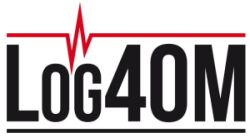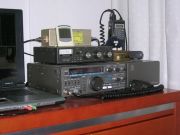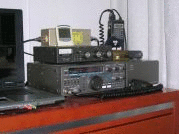Propagation




* 1 to 6 is BEST
* 7 to 9 is OK
* 11 or more is BAD
Represents the overall geomagnetic condition of the ionosphere ("Ap" if averaged from the Kp-Index)(an average of the eight 3-hour K-Indices) ('A' referring to amplitude) over a given 24 hour period, ranging (linearly) typically from 1-100 but theoretically up to 400. A lower A-Index generally suggests better propagation on the 10, 12, 15, 17, & 20 Meter Bands; a low & steady Ap-Index generally suggest good propagation on the 30, 40, 60, 80, & 160 Meter Bands.
SFI index [ HIGH is GOOD ]
* 70 NOT GOOD
* 80 GOOD
* 90 BETTER
* 100+ BEST
The measure of total radio emissions from the sun at 10.7cm (2800 MHz), on a scale of 60 (no sunspots) to 300, generally corresponding to the sunspot level, but being too low in energy to cause ionization, not related to the ionization level of the Ionosphere. Higher Solar Flux generally suggests better propagation on the 10, 12, 15, 17, & 20 Meter Bands; Solar Flux rarely affects the 30, 40, 60, 80, & 160 Meter Bands.
K index [ LOW is GOOD ]
* 0 or 1 is BEST
* 2 is OK
* 3 or more is BAD
* 5 is VERY VERY BADb>
The overall geomagnetic condition of the ionosphere ("Kp" if averaged over the planet) over the past 3 hours, measured by 13 magnetometers between 46 & 63 degrees of latitude, and ranging quasi-logarithmically from 0-9. Designed to detect solar particle radiation by its magnetic effect. A higher K-index generally means worse HF conditions.
A lower K-Index generally suggests better propagation on the 10, 12, 15, 17, & 20 Meter Bands; a low & steady Kp-Index generally suggest good propagation on the 30, 40, 60, 80, & 160 Meter Bands.
SFI - Solar Flux Index ------ higher number are better
Ap - Planetary Index ------- the lower the better, high means noisy band conditions
K - K Index -------------------- the lower the better, high means greatly disturbed
*Solar Flux Index (SFI):
Solar activity determines the amount of radiation we get from the sun. SFI is measured in Solar Flux Units, and varies between 50 and 300. In general (and NOT locally) SFI around 50 shows Maximum Useable Frequency (MUF) will be low maybe about 12 MHz, whereas SFI around 300 shows MUF will be pretty high, well into VHF frequencies. Expect low SFI values around bottom of sunspot cycle and high SFI values around peak of (+/- 11 year) sunspot cycle
*Geomagnetic activity indices, K and A.
As the number of sunspots rises, more solar particles hit the geomagnetic field of the Earth. This causes the Earth’s magnetic field to behave differently. As the solar stream disrupts the geomagnetic field, HF conditions degrade and M.U.F. gets suppressed. Hence the need to monitor and measure the geomagnetic state.
K-index:
Local index of magnetic activity relative to an assumed quiet-day curve for a single geomagnetic observatory site. Ranges from 0 through to 9 and largest value is recorded at a 3-hour interval of UTC time.>
Kp-Index:
Planetary average of all the K indices around the world. Values about 0 to 1 represent quiet magnetic conditions and this would indicate good HF conditions, whereas 7 to 9 represent a very major storm that could result in a blackout of HF communications.
A-index is for daily average of local geomagnetic activity, and is generated by the 3-hour K index.(We need it as K index is quasi-logarithmic, not suitable for daily averages.)
ap-index -> a measure of the general geomagnetic activity over the planet for any given day.
Ap-index-> a daily, planetary index, calculated from 8 ap indices.Ranges from 0 to 400.Values from 0 to 3 represent quiet conditions, whereas anything over 80 indicates a storm.






